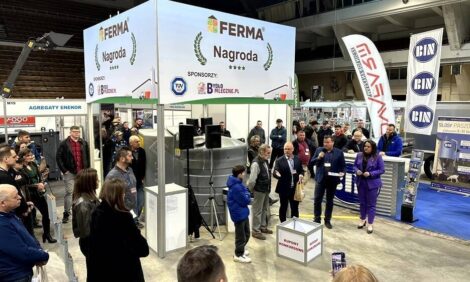



Strong Growth in Germany's Organic Laying Flock
GERMANY - Total egg production and consumption have increased in the 12 months since the last official statistics in December 2011, with particularly strong growth in the organic sector although floor systems account for two-thirds of production.The German statistics agency, Destatis, reports that there were a total of 36.6 million laying hens in the country - on farms with at least 3,000 hen places - on 1 December 2012. That represents an increase of 7.5 per cent from December 2011. Growth in the organic sector was particularly strong at 17.0 per cent but there were also increases in floor systems (+8.9 per cent) and free-range (+8.7 per cent). There was a 4.2 per cent fall in the number of layers in modern cages.
Total capacity was reported to the around 42 million hen places, of which 26.8 million (64.0 per cent) were in floor systems, 6.1 million free-range (14.6 per cent) and 5.5 million (13.2 per cent) in cages. Since the ban on conventional battery cages came into effect in 2009, the only cages permitted are colony systems and enriched cages. There were 3.4 million places in the organic sector (8.2 per cent). Overall, 87.2 per cent of total capacity was in production.
Hen places have increased since the battery cage ban
The ban on conventional battery cages in Germany since 1 January 2009 has impacted the development of layer housing. After the end of the transition year, in 2010, the national flock has continued to increase such that, on 1 December 2012, there were again more than 37 million laying birds, seven million more than in 2010. The rise in hen places to almost 42 million represents an increase of 14.1 per cent.
Around 2.5 million (5.7 per cent) more layer chicks than in 2010
The continuous increase in the laying flock stems from the hatcheries. The number of layer chicks hatched in 2012 was 46.6 million, or around 2.5 million (5.7 per cent) more than in 2010. In the transition year 2009, the number was 40.3 million.
Floor systems predominate
Accounting for 26.8 million laying hen places, floor systems are the most popular housing option for German egg farms. As the result of an increase of 1.1 million places (4.3 per cent) in floor systems since December 2011, this sector now accounts for 64.0 per cent of total capacity. The statistics show a total of 23 million hens - an increase of 8.9 per cent - in floor systems in 2012. Almost two out of every three hens (63.8 per cent) are kept in such systems.
Free-range is second most important system
A further increase in the free-range sector was recorded from December 2011. This system accounts for 6.1 million places (6.0 per cent) and 5.4 million hens (8.7 per cent). This makes free-range systems the second most popular choice for German egg farms, accounting for 14.6 per cent of all hen-places.
Further reductions in small colony cages and enriched cages
The numbers of hen places in these two types of cages on the survey date of 1 December 2012 was down again. At that time, there were one per cent fewer hen-places in these systems at 5.5 million. The actual number of hens was 4.9 million - 4.2 per cent fewer than a year previously.
Organic production up by 16.4 per cent
The organic sector has also been gaining in popularity. Compared to the year before, there were 483,000 hen-places in this category (+16.4 per cent) and 422,000 birds - an increase of 17.0 per cent - in December 2012.
Egg consumption up
Along with the increase in hen numbers and egg production, consumption has also risen. In the first 11 months of 2012, 9.7 billion eggs were consumed in Germany - 9.9 per cent more than in the same period of the previous year. If the trend continued for the last month of 2012 with 37 million hens, total production for the year is forecast to be 10.6 billion eggs.
| Farms with laying hen places1 and numbers by production system | |||||
|---|---|---|---|---|---|
| Hen-places | Hens | ||||
| Year | No. of farms | Number | Change from previous year (%) | Number | Change from previous year (%) |
| Total | |||||
| 2008 | 1,189 | 39,929,992 | - 0.2 | 31,705,900 | - 0.3 |
| 2009 | 1,111 | 37,344,316 | - 6.5 | 26,846,197 | - 15.3 |
| 2010 | 1,139 | 36,716,585 | - 1.7 | 29,872,571 | + 11.2 |
| 2011 | 1,224 | 40,026,905 | + 9.0 | 34,017,571 | + 13.9 |
| 2012 | 1,277 | 41,907,218 | + 4.7 | 36,553,038 | + 7.5 |
| Floor systems | |||||
| 2008 | 604 | 8,659,350 | + 27.3 | 7,186,699 | + 25.8 |
| 2009 | 705 | 16,629,469 | + 92.0 | 13,323,768 | + 85.4 |
| 2010 | 783 | 23,045,007 | + 38.5 | 18,975,923 | + 42.3 |
| 2011 | 813 | 25,720,126 | + 11.6 | 21,430,045 | + 12.9 |
| 2012 | 835 | 26,827,133 | + 4.3 | 23,327,847 | + 8.9 |
| Cage systems | |||||
| 2008 | 587 | 24,777,300 | - 8.4 | 18,868,534 | - 13.9 |
| 2009 | 275 | 14,069,387 | - 43.2 | 7,572,165 | - 59.9 |
| 20102 | 155 | 6,681,875 | - 52.5 | 4,694,983 | - 38.0 |
| 2011 | 128 | 5,566,757 | - 16.7 | 5,120,882 | + 9.1 |
| 2012 | 127 | 5,511,452 | - 1.0 | 4,905,228 | - 4.2 |
| Free-range systems | |||||
| 2008 | 248 | 4,451,573 | + 1.7 | 3,916,835 | + 12.6 |
| 2009 | 258 | 4,297,494 | - 3.5 | 3,858,729 | - 1.5 |
| 2010 | 277 | 4,729,275 | + 10.0 | 4,265,621 | + 10.5 |
| 2011 | 314 | 5,787,584 | + 22.4 | 4,981,086 | + 16.8 |
| 2012 | 336 | 6,133,279 | + 6.0 | 5,412,338 | + 8.7 |
| Organic systems | |||||
| 2008 | 119 | 2,041,769 | + 14.6 | 1,733,832 | + 9.5 |
| 2009 | 148 | 2,347,966 | + 15.0 | 2,091,535 | + 20.6 |
| 2010 | 148 | 2,260,428 | - 3.7 | 1,936,044 | - 7.4 |
| 2011 | 194 | 2,952,438 | + 30.6 | 2,485,558 | + 28.4 |
| 2012 | 221 | 3,435,354 | + 16.4 | 2,907,625 | + 17.0 |
| 1 On farms with at least 3,000 places. 2 Since 2010, permitted cages are of the small colonies and enriched types. |
|||||








